David Whythe - BBC Research Career
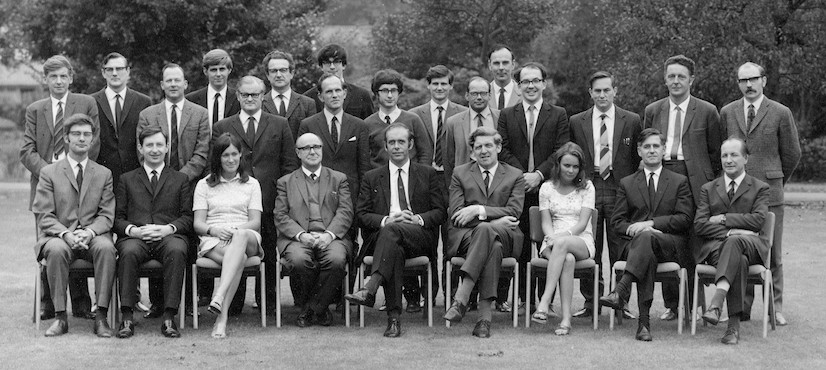
BBC Research Department, group photograph, 1970
Dad is second from right, seated in the front row.
His main task (in general terms) was to assess radio signal strength and to predict reception quality at various points around the country.
I remember one of the responsibilities he most enjoyed was to predict the signal strength in the Scottish region, where the mountains tended to mask VHF signals, and where most of the local population lived and worked in the valleys, where signal strength was weakest. He therefore tried to identify the geographical locations for radio transmitter aerials which would give the best reception for the greatest number of people, while also limiting the visual impact of transmitter aerials on the skyline.
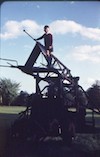
To test his predictions, he arranged for a temporary test aerial to be mounted at a specified location, and for it to transmit a test signal for a period. He then spent two weeks driving around the Scottish Highlands, testing the signal strength as he went. Those two weeks were heaven for him.
The picture at left is of me in 1961, using his mobile transmitter aerial (collapsed for transport) as a climbing frame!
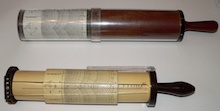 As
part of Dad's calculations for his predictions, he often
needed to use complex numbers - which combine a normal
"real" number with an "imaginary" component. Since these
were the days before electronic calculators, he used a slide
rule as his main tool. But these only supported normal
"real" numbers, and could not carry out multiplication or
division for complex numbers. So in 1960 he invented what
became the Whythe-Fuller slide
rule to do this for him.
As
part of Dad's calculations for his predictions, he often
needed to use complex numbers - which combine a normal
"real" number with an "imaginary" component. Since these
were the days before electronic calculators, he used a slide
rule as his main tool. But these only supported normal
"real" numbers, and could not carry out multiplication or
division for complex numbers. So in 1960 he invented what
became the Whythe-Fuller slide
rule to do this for him.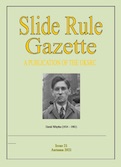 He designed the original
prototype version (above, in the picture at left), which was
built in the BBC workshops, to prove the concept. The design
was then passed to the Stanley tool company, who built the
commercial version for general sale (below). This brought
him a small amount of money by way of the patent rights, but
since it had a very limited market (with few people needing
to multiply complex numbers) and the period it was on sale
was short (production closed in 1967), this was not a major
income stream for him. But the relative rarity caused by the
limited market and the short production period means that
these slide rules are now rare collector's items. As such,
Dad was featured as the main subject of the Slide Rule
Gazette, issue 21, in Autumn 2021 (the newsletter for the UK Slide Rule Circle).
He designed the original
prototype version (above, in the picture at left), which was
built in the BBC workshops, to prove the concept. The design
was then passed to the Stanley tool company, who built the
commercial version for general sale (below). This brought
him a small amount of money by way of the patent rights, but
since it had a very limited market (with few people needing
to multiply complex numbers) and the period it was on sale
was short (production closed in 1967), this was not a major
income stream for him. But the relative rarity caused by the
limited market and the short production period means that
these slide rules are now rare collector's items. As such,
Dad was featured as the main subject of the Slide Rule
Gazette, issue 21, in Autumn 2021 (the newsletter for the UK Slide Rule Circle).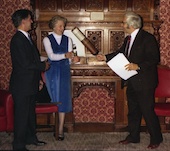
At Dad's retirement in 1980, Dr Charles Sandbank, Head of BBC R&D, presented him with his prototype slide rule, to keep as a memento. Or at least, he presented it to Mum, suggesting she use it as a rolling pin, and that she might find it useful for keeping Dad in order.
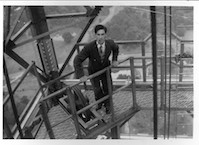
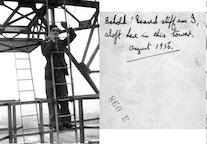
Part of Dad's induction into radio transmission equipment was, early on, to climb a few of the transmitter masts to check out the equipment mounted at the very top.
At left he is pictured in 1960, 400 feet up the transmitter mast at Crystal Palace, while on the right is a photo he sent home in 1956, showing him "scared stiff" up an aerial tower.
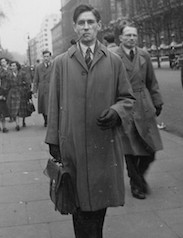
His work often took him into London, usually to Broadcasting House. On one occasion he was pictured as a typical London commuter.
As you can see, his pipe was a regular part of his "uniform", throughout his life, and his favourite tobacco was Bondman.